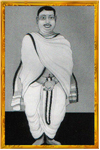 The most exalted musical personal in Swati Tirunal’s court was Meruswami. He was cultivating music as a form of yoga and was well versed in Hindusthani and Karnatic music in theory and practice. His high pitched voice and capacity to effortlessly traverse the three registers of the gamnut, earned him the name kokilakantha (the cuckoo-voiced). He was a pioneer in popularising the musical discourse commonly known as ‘Harikathakalakshepam’, music –religious entertainment which originated in Maharashtra. He held a position of great esteem in the court of king Serfoji at Tanjore. Due to the persistent efforts of Subba Rao, Meruswami was persuaded to make a visit to Trivandrum in 1833.
The most exalted musical personal in Swati Tirunal’s court was Meruswami. He was cultivating music as a form of yoga and was well versed in Hindusthani and Karnatic music in theory and practice. His high pitched voice and capacity to effortlessly traverse the three registers of the gamnut, earned him the name kokilakantha (the cuckoo-voiced). He was a pioneer in popularising the musical discourse commonly known as ‘Harikathakalakshepam’, music –religious entertainment which originated in Maharashtra. He held a position of great esteem in the court of king Serfoji at Tanjore. Due to the persistent efforts of Subba Rao, Meruswami was persuaded to make a visit to Trivandrum in 1833.
When he saw the pious Maharaja and noticed his fervour for music, he felt an intellectual kinship with him and extended his stay again and again, and finally in response to his request chose to settle down in Trivandrum. In 1836 he accepted the position of royal musician. The Maharaja became his disciple and learnt from him the secrets and intricacies of higher music and became a nadopasaka. A spacious house was built for him near the western entrance to the Padmanabhaswami temple which bears to this day the name ‘Meruswami mathom’. A special palanquin was also made for his use, a rare royal honour. A decent monthly allowance was provided for him; so too for his mridanagam accompanist Hari Rao. During the Srirama Navami festival which he conducted in his residence, the Maharaja used to make his visits, an extremely rare gesture in those days. In a letter written by Tulajarama Rao, son of Subba Rao, to a relation of his at Pudukotta in September 1836, it is stated: “Now there is no lack of music and dancing at Trivandrum and we are continually regaled almost to satiety by the vocal harmony of Meruswami who is nor completely become a Travancore like us.” The composition of the two musical narratives of Swati Tirunal, Kuchelopakhyana and Ajamilopakhyana, comprising verses and songs in Maharashtra musical types like Saki, Ovi, Dindi and Abhang, was inspired by Meruswami. He presented Kuchelopakhyana on stage in February 1838 and was gifted with Rs.500/-, a pair of gold bangles, shawl and a necklace.
An important matter which deserves to be particularly noted with regard to Meruswami is that not only was he a guru of Swathi Tirunal, but he came to be considered as a ‘kulaguru’ a guru of the Travancore royal family for all time. He became intimately and permanently associated with the Travancore royal house as a spiritual preceptor.


